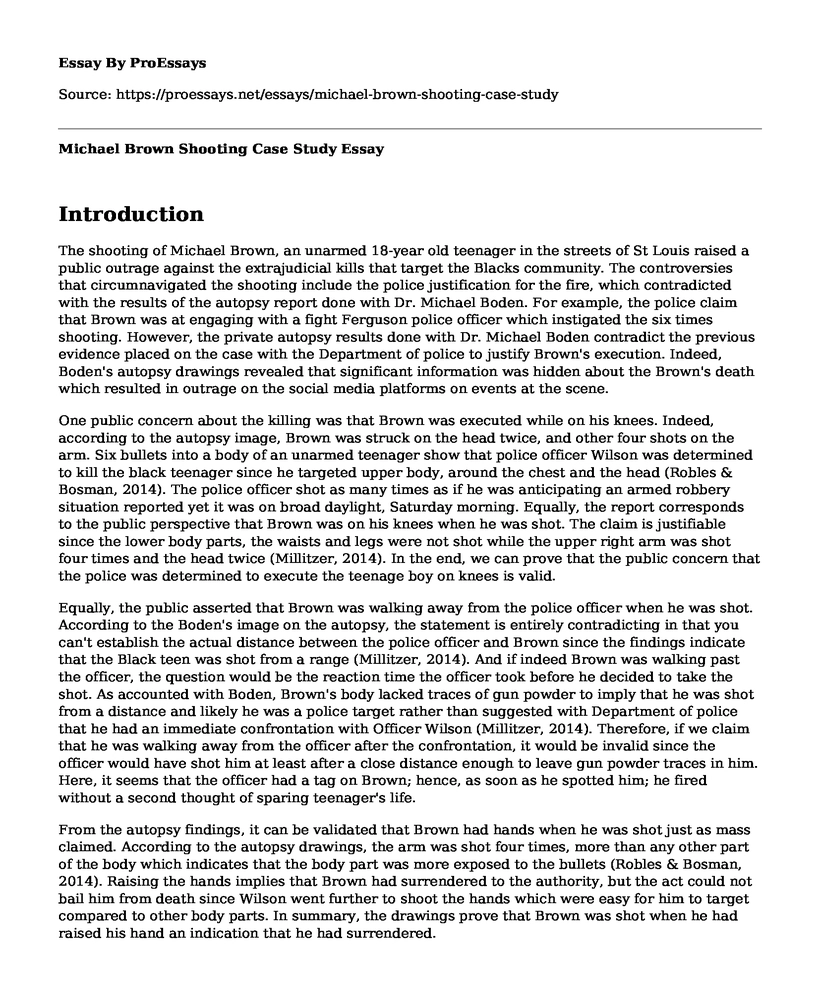Introduction
The shooting of Michael Brown, an unarmed 18-year old teenager in the streets of St Louis raised a public outrage against the extrajudicial kills that target the Blacks community. The controversies that circumnavigated the shooting include the police justification for the fire, which contradicted with the results of the autopsy report done with Dr. Michael Boden. For example, the police claim that Brown was at engaging with a fight Ferguson police officer which instigated the six times shooting. However, the private autopsy results done with Dr. Michael Boden contradict the previous evidence placed on the case with the Department of police to justify Brown's execution. Indeed, Boden's autopsy drawings revealed that significant information was hidden about the Brown's death which resulted in outrage on the social media platforms on events at the scene.
One public concern about the killing was that Brown was executed while on his knees. Indeed, according to the autopsy image, Brown was struck on the head twice, and other four shots on the arm. Six bullets into a body of an unarmed teenager show that police officer Wilson was determined to kill the black teenager since he targeted upper body, around the chest and the head (Robles & Bosman, 2014). The police officer shot as many times as if he was anticipating an armed robbery situation reported yet it was on broad daylight, Saturday morning. Equally, the report corresponds to the public perspective that Brown was on his knees when he was shot. The claim is justifiable since the lower body parts, the waists and legs were not shot while the upper right arm was shot four times and the head twice (Millitzer, 2014). In the end, we can prove that the public concern that the police was determined to execute the teenage boy on knees is valid.
Equally, the public asserted that Brown was walking away from the police officer when he was shot. According to the Boden's image on the autopsy, the statement is entirely contradicting in that you can't establish the actual distance between the police officer and Brown since the findings indicate that the Black teen was shot from a range (Millitzer, 2014). And if indeed Brown was walking past the officer, the question would be the reaction time the officer took before he decided to take the shot. As accounted with Boden, Brown's body lacked traces of gun powder to imply that he was shot from a distance and likely he was a police target rather than suggested with Department of police that he had an immediate confrontation with Officer Wilson (Millitzer, 2014). Therefore, if we claim that he was walking away from the officer after the confrontation, it would be invalid since the officer would have shot him at least after a close distance enough to leave gun powder traces in him. Here, it seems that the officer had a tag on Brown; hence, as soon as he spotted him; he fired without a second thought of sparing teenager's life.
From the autopsy findings, it can be validated that Brown had hands when he was shot just as mass claimed. According to the autopsy drawings, the arm was shot four times, more than any other part of the body which indicates that the body part was more exposed to the bullets (Robles & Bosman, 2014). Raising the hands implies that Brown had surrendered to the authority, but the act could not bail him from death since Wilson went further to shoot the hands which were easy for him to target compared to other body parts. In summary, the drawings prove that Brown was shot when he had raised his hand an indication that he had surrendered.
Conclusion
In conclusion, Boden's autopsy drawing scraped off the previous evidence formulated with police to justify the killing; it changed the direction of the case and made the police department to look stupid. The critical piece of evidence proved that more investigation had to be done to find the root cause of that extrajudicial killing.
References
Millitzer, J. (2014). Brown family to hold press conference Monday on autopsy findings. Retrieved from https://kplr11.com/2014/08/18/brown-family-to-hold-press-conference-monday-on-autopsy-findings
Robles, F., & Bosman, J. (2014). Autopsy Shows Michael Brown Was Struck at Least 6 Times. Retrieved from https://www.nytimes.com/2014/08/18/us/michael-brown-autopsy-shows-he-was-shot-at-least-6-times.html
Cite this page
Michael Brown Shooting Case Study. (2022, Dec 09). Retrieved from https://proessays.net/essays/michael-brown-shooting-case-study
If you are the original author of this essay and no longer wish to have it published on the ProEssays website, please click below to request its removal:
- Article Review Example on Biological Criminal Behavior
- A Response to Three Texts on the Civil Rights Movements
- Immigration Act of 2016 Essay
- Should Juveniles Receive Life Sentences and Tried as Adults - Essay Sample
- Research Paper on Childhood and Criminal Activity
- Cybercrime vs. Cyberterrorism: Understanding the Difference - Essay Sample
- Essay Sample on Law Order: Establishing Rules for Social Control Crime Punishment







